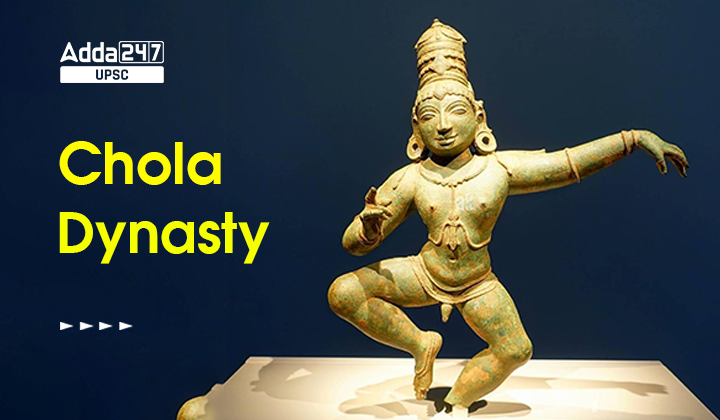Table of Contents
Chola Dynasty- The imperial Chola dynasty was one of the most prominent and longest-ruling dynasties in the history of India tenure was (9th century AD to 13th Century AD ). The Chola dynasty rose to power in the 9th century AD and continued to dominate South India for over 400 years until the 13th century AD.
The Chola kingdom was located in present-day Tamil Nadu and parts of southern India, and it had a strong influence on the cultural, economic, and political landscape of the region. The dynasty is particularly renowned for its achievements in art, architecture, literature, and maritime trade, making it one of the most important cultural and economic centres of ancient India.
Chola Dynasty Founder
The imperial Chola dynasty was founded by Vijayalaya Chola in the 9th century AD. He was a feudatory of the Pallava dynasty and initially ruled over a small territory in present-day Tamil Nadu, India. However, he gradually expanded his kingdom by conquering neighbouring territories and established the Chola dynasty as a major power in South India.
Vijayalaya Chola was succeeded by his son Aditya I, who further expanded the Chola kingdom and consolidated its power. The Chola dynasty went on to become one of the most powerful and influential dynasties in South India, and its reign is considered a golden age in Tamil Nadu’s history.
Vijayalaya Chola (850 AD-871 AD)
Vijayalaya Chola was the founder of the imperial Chola Dynasty and ruled from Thanjavur in the 9th century CE. He was a great warrior who defeated the Pallavas and established his kingdom.
He is also credited with building the first temple in the city of Thanjavur, which became the political and cultural centre of the Chola Dynasty. Vijayalaya Chola laid the foundation for the Chola Empire, which went on to become one of the most prominent dynasties of South India.
Chola Dynasty Family Tree
Vijayalaya Chola (850-871): Founder of the Chola dynasty
Aditya I (871-907): Son of Vijayalaya Chola and second king of the Chola dynasty
Parantaka I (907-950): Son of Aditya I and third king of the Chola dynasty
Gandaraditya (950-957): Son of Parantaka I and fourth king of the Chola dynasty
Arinjaya (957-1014): Son of Gandaraditya and fifth king of the Chola dynasty
Rajaraja Chola I (1014-1044): Son of Arinjaya and one of the greatest kings of the Chola dynasty
Rajendra Chola I (1012-1044): Son of Rajaraja Chola I and one of the most successful kings of the Chola dynasty
Rajadhiraja Chola (1044-1052): Son of Rajendra Chola I and eighth king of the Chola dynasty
Virarajendra Chola (1063-1070): Son of Rajendra Chola I and the last king of the Chola dynasty.
It’s worth noting that the Chola dynasty had many other members who played important roles as administrators, generals, and diplomats, but this family tree covers the succession of kings.
Chola Dynasty Capital
The imperial Chola dynasty had several capital cities over the course of its reign, but the most famous and significant of these was Thanjavur (also known as Tanjore), which served as the capital during the reign of Rajaraja Chola I and his son Rajendra Chola I. Thanjavur was located in present-day Tamil Nadu, India, and was a major center of Tamil culture and arts during the Chola period.
The Chola kings built several magnificent temples and palaces in and around Thanjavur, including the famous Brihadeeswara Temple, which is now a UNESCO World Heritage Site. The city was also an important center of trade and commerce, with a bustling port on the nearby Kaveri River. Thanjavur remained an important cultural and political center even after the decline of the Chola dynasty, and it continues to be an important tourist destination in India today.
From the ninth until the thirteenth century CE, the Tamil Chola dynasty dominated southern India. Although historians disagree on the precise length of the Chola dynasty, it is widely agreed that it lasted from the 9th century CE, during the rule of Vijayalaya Chola, to Rajendra Chola III’s defeat by the Pandya dynasty in the 13th century CE. Hence, the Chola dynasty’s reign lasted roughly from the ninth century CE to the thirteenth century CE.
Chola Dynasty Temple
The Chola dynasty is famous for its architectural achievements, particularly its magnificent temple buildings. Some of the most famous temples built during the Chola dynasty include:
- Brihadeeswarar Temple in Thanjavur – built by the Chola king Raja Raja I in the 11th century CE, this temple is one of the largest and most impressive temples in India, with a towering 66-meter-high vimana or tower. This temple is considered to be a standing alone milestone.
- Airavatesvara Temple in Darasuram – built by the Chola king Rajaraja II in the 12th century CE, this temple is known for its intricate carvings and sculptures, including a stunning Nandi bull.
- Gangaikonda Cholapuram Temple – built by the Chola king Rajendra Chola I in the 11th century CE, this temple is known for its towering vimana and its intricately carved stone walls.
- Thillai Nataraja Temple in Chidambaram – an ancient temple dedicated to Lord Shiva, was patronized and expanded by several Chola kings.
- Kailasanathar Temple in Kanchipuram – built by the Chola king Rajasimha in the 8th century CE, this temple is known for its elaborate carvings and sculptures.
These temples are not only important religious sites but also UNESCO World Heritage Sites, attracting millions of visitors from around the world every year.
Chola dynasty and Administration
- Cholas united the entire Southern India region.
- The kingdom was divided into provinces which were known as mandalams.
- Mandalams were further divided into districts called nadus.
- Nadus consisted of Tehsils.
- The Cholas were patrons of art, poetry, literature and drama, and made significant contribution in the construction of several temples and complexes with sculptures and paintings. one of which is Brihadeshwara temple, which is UNESCO world heritage site.
- The major decisons were taken by the king as he acted as the central authority in major issues.
Chola Dynasty for UPSC Exam
The Chola dynasty is an important topic for the UPSC exam as it was one of the most prominent dynasties of ancient India. It is an important topic for UPSC GS 1 and History optional as ancient history forms important part of the UPSC CSE syllabus. Here are some important points to keep in mind while studying the Chola dynasty for the UPSC exam:
- Origin and expansion of the Chola dynasty: The Chola dynasty originated in the Tamil region of southern India and rose to prominence during the 9th century CE. It expanded its territory through a series of conquests and established a vast empire that covered much of South India, Sri Lanka, and parts of Southeast Asia.
- Administrative system: The Chola dynasty is known for its highly efficient administrative system, which was based on a hierarchy of officials and a well-organized system of revenue collection. The Cholas also introduced several reforms in the legal and judicial systems, which had a lasting impact on the administration of South India.
- Economic achievements: The Chola dynasty was known for its economic prosperity and maritime trade. It had a well-developed system of ports and trade routes that facilitated the exchange of goods and ideas with other regions of the world.
- Cultural and artistic achievements: The Chola dynasty was a patron of art, literature, and architecture. It is known for its magnificent temple architecture, which reflects the Chola’s religious and cultural beliefs. The Cholas also contributed significantly to Tamil literature and music.
- Decline and legacy: The Chola dynasty declined in the 13th century CE, partly due to invasions by the Pandyas and the Chalukyas. However, its legacy continued to influence South India for centuries to come, and the Chola kings are remembered as some of the greatest rulers of ancient India.
Check: All UPSC Notes for Indian History
| ALSO READ | |
| Mauryan Age | 16 Mahajanapadas |
| Gurjara Pratiharas Rulers | Kushan Dynasty |



 TSPSC Group 1 Question Paper 2024, Downl...
TSPSC Group 1 Question Paper 2024, Downl...
 TSPSC Group 1 Answer key 2024 Out, Downl...
TSPSC Group 1 Answer key 2024 Out, Downl...
 UPSC Prelims 2024 Question Paper, Downlo...
UPSC Prelims 2024 Question Paper, Downlo...





